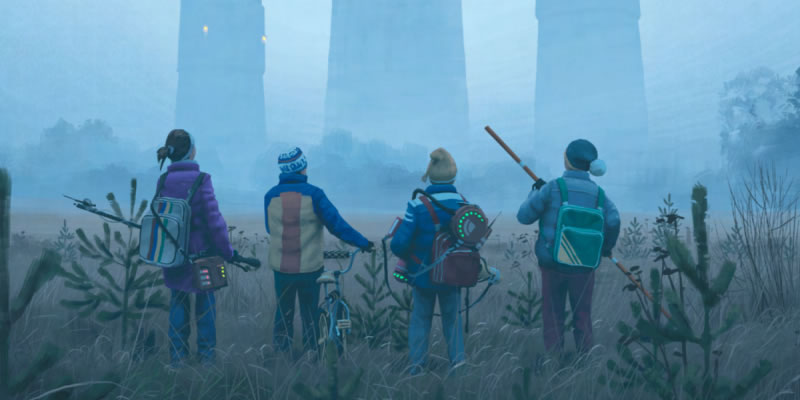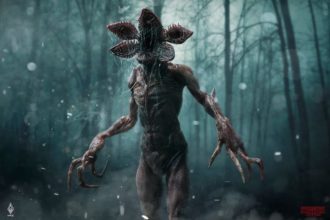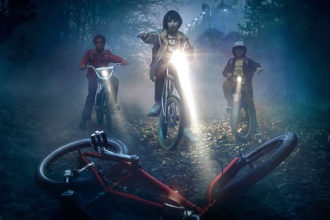Running a Kids on Bikes One-Shot Adventure
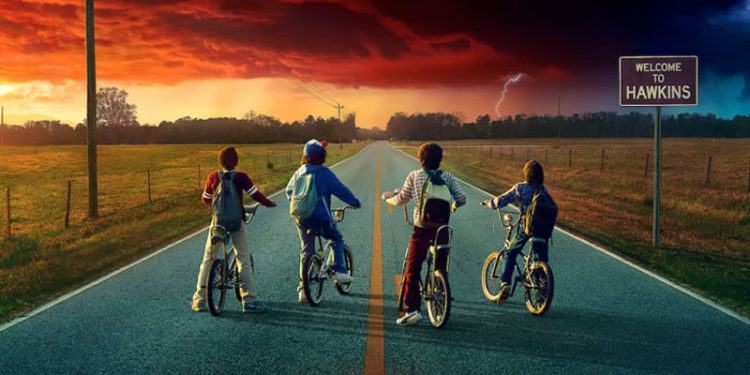
Since the release of Stranger Things back in July 2016, the Kids on Bikes sub-genre of sci-fi/horror, is pedaling at full speed! This sub-genre was first popularized back in the 80s through the works of Spielberg and King, such as E.T.: The Extra-Terrestrial, Stand By Me and The Goonies. This fall is looking like the season of the bike with IT breaking September box office records and Stranger Things 2 looking to consume massive bandwidth this weekend.
Like a nostalgic blur, I can still remember those summer breaks back in the 80s where my friends and I disappeared into the labyrinth of bike paths and woodlots between the houses in my Toronto suburb. These days I feel more like the father from Stand by Me stuck at a computer writing, than the kids in these movies that I share a similar birth year with. Watching these movies for me, as a kid or as an adult, awakens feelings of freedom and adventure that only a pre-teen on a bike leaving the watch of protective parents can experience.
This article will look at how to run your own Kids on Bikes one-shot adventure. I’ll be taking a look at tropes of the sub-genre, how to structure your adventure, what rules work might work best for this type of adventure and some sources to check out for inspiration.

Tropes of the Kids on Bikes Sub-genre
Let’s break down some of the shared and typical tropes that are found in the comics, movies and shows of this sub-genre.
1) Bikes
Bikes are a must have for this type of adventure, and not just because they are typical and titular for the sub-genre. Bikes represent and provide the first taste of freedom for the kids, allowing them to find trouble with no adults around, making these adventures possible.
- Bikes limit the kids to roaming a neighborhood or small town, keeping your story small
- Bikes are quiet and stealthy, allowing the kids to quietly travel and explore freely, slipping between the cracks and paths most traveled
- Stand By Me provide another travel idea with the kids ditching their bikes to travel along a train track and camping along the way, but bikes got them there
I would recommend having the players describe which type of bike they have, as an extension of their personality. In this sub-genre, someone who rides a BMX is much different than someone who rides a pedal bike with a basket.
2) A Hideout
The kids often have a place to call their own, that they don’t have to worry about adults. This place could be under a bridge (Lucas), a basement (Stranger Things), a treehouse (Stand by Me) or even just one of the kids houses where the parents (or parent) are always at work (The Goonies, Super 8).
Have the players describe their hideout as a group at the start of the adventure.
3) Misfits
The gang of kids is often a bunch of misfits that don’t fit in with the popular kids for numerous reasons. This opens them up to being bullied or at least puts them on the outside of the popular crowd. The 80s was a different time and things that created a misfit back then might not even be a challenge today. For your adventure, ask your players to create PCs who would be considered misfits in the 1980s for reasons such as:
- computers skills, book smarts and other stuff that is considered weird
- being poor, skinny or overweight, having asthma, a tomboy, wearing glasses or just being different
- being a social outcast for anything from being shy to a loudmouth
Another interesting choice a player could opt for is creating a popular kid that falls in with the group, finding out they can be themselves, even if it is likely only a temporary friendship.
4) A Time of Change
The many Kids on Bikes movies of the 1980s were generally set in the time around when when the movie was released, but there are exceptions such as Stand By Me which is set in 1959. Recent entries in the sub-genre have tended to set themselves back in the 80s as well.
- You should try to place your story in the 1980s, which limits the kids to technology such as the public library, walkie talkies and rudimentary electronic gadgets and computers
- The genre tends to be set in the last weeks of summer or fall, a time of change
- I would avoid snowy winter, as it makes riding bikes hard, but try out kids on snowmobiles if you like
5) Small Towns & Suburbia
Your story can be set anywhere, but 1980s small towns and suburbia work better than the city.
- Small towns have more prying eyes than suburbia, but they have even more cracks to slip into and explore
- Suburbia allows for some of the anonymity of the city, with many adults away at work in the city
- Both can provide culverts, storm drains, empty lots, caves, and deep woods to explore far away from the watch of adults
- Either one should be presented as idyllic on the surface, where something darker is lurking behind the picket fences
Look for maps online of real places, steal a town from an established setting (see Tales from the Loop and Bubblegumshoe below), create a fictional town or pull your own town/suburb from your youth.
6) Adults and Authority Figures
In the Kids on Bikes sub-genre, the adults are usually struggling to get by or are even completely lost (Stranger Things has plenty of this). Their main purpose is help define kid protagonists and provide a contrast to the kids.
Parents and adults in the story often have some of the following challenges:
- distant, emotionally unavailable or experiencing some form of mental illness
- substance abuse
- stuck in an abusive relationship
- divorced or widowed
- busy with work issues
- having financial problems
The adults are too wrapped up with their own problems to notice the activity of the kids, unless they get in trouble with school or the police. When it comes helping the kids, they won’t help or even need to be avoided. This doesn’t mean that all adults need to be unsympathetic, but it’s the broken adults that drive Kids on Bikes stories, forcing the kids into action.
The authority figures presented in the stories come in all types of forms such as businessmen, soldiers, scientists, police or even government agents. In almost all cases, they are shown to be cold, sinister, faceless, possessing weapons or advanced technology and most important, not to be trusted. The most typical example of this is the hazmat suit, found in ET, Super 8 and Stranger Things.
Help your players create one or two adults in their life.
7) The Monster
Last but not least is the monster. On the way to finding the monster, the kids should experience challenges facing off against other kids, adults and even the environment, which might even be more important than a final showdown. The monster can take many forms and should stay in the background as long as possible. The typical Kids on Bikes threat isn’t defeated in a final showdown where they battle a monstrous threat, save the day and get treasure. The monster is generally used to represent a fear of growing up and can’t really be defeated.
For your own adventure, try to create a monster that is terrifying but misunderstood, rather than than murderous and evil. Whatever the nature of your monster, provide a way to defeat the monster through problem solving, rather than combat. Remember, your players are running kid PCs who are far less powerful than even regular grown-ups.

How to Structure Your Adventure
I’m borrowing this story structure from a few sources, but mainly Tales from the Loop (see below). Like the 5 Room Dungeon, a mystery can be broken down into 5 parts too. I’m not doing all of the work for you here, you’ll need to come up with your own idea.
Introduce the Kids
- Take the time to introduce the kids
- This can be done with a simple character descriptions for each kid or short scenes of everyday life with each kid and an NPC
- Try to keep these short (you are running a one-shot), but long enough to get to know each kid
Introduce the Mystery
- With the kids together and roaming around on bikes, have them discover something or someone that requires investigation
- This is the hook, give them just of glimpse of what is going on and hopefully they will grab it without too much prodding
- The introduction should provide a clue or something that leads to one of 3 locations
Solve the Mystery
- The easiest way to run a mystery adventure is to have the characters visit 3 locations, which works best if you can provide some form of map
- Each location should provide a clue or clues. This can be in the form of a person who has answers or something they find
- Let the players work a bit, but eventually they should be given the clue
- The work shouldn’t be finding the clues as much as piecing them together to figure out what is going on, who is threatening them and other trouble, and where to go next
- Feel free to break up these scenes with more everyday life scenes that can provide some trouble such as facing bullies, getting grounded for missing curfew or even driven home by the police
- If you want to ramp up the tension, add a countdown where events will start to happen as the story progresses and the players haven’t solved the mystery
Showdown
With all the clues assembled, the players should know what is going on and be pointed towards a final showdown. If your players are having trouble solving the mystery you can:
- try using a lucky break where they are given more info that should help push them to a solution
- have the countdown timeout and the showdown confronts the kids
Regardless of how the kids get there, the showdown is here and it is time to stop bad things from happening. The adventure should have shown the kids that they can’t count on adults to help and they are on their own. Whether the kids are successful or they fail, the story reaches its climax.
Aftermath
The showdown should have provided answers for the mystery. It is also likely new questions have emerged, which can be great for running another one-shot or even a full campaign.
Life has moved on in the days or weeks since the showdown. The kids might be the only ones that knew about the event, all evidence of the event has disappeared, or the event might even be cleaned up or kept under wraps by some authority. They aren’t celebrated as heroes and simply go back to their regular lives of fighting parents, bullies, and midterms.
Run a short scene at the kids hideout with them all together to give the players a chance to talk about what happened. Provide the kids with a newspaper, a TV broadcast or something else that explains away the event as swamp gas, military tests or an obvious cover-up.
What Rules Work Best for this Type of Adventure
I’m not going to answer that question for your, but I will provide the following five recommendations for you to consider.
Fate Accelerated
This condensed version of the Fate Core system is relatively quick to learn and character creation is relatively simple. The game is flexible enough to handle any adventure and works well with scenes.
Bubblegumshoe
Based on Gumshoe, this game was created to run adventures where “intrepid teen sleuths” solve mysteries. The game works well for high school or middle school, provides various small town settings and provides your with ways to discover clues, solve problems (tests) and handle both social and physical conflicts.
End of the World
This game by Fantasy Flight Games comes in four flavors with zombies, gods, aliens and machines all providing a multitude of apocalypse scenarios for your kids to survive. The stories are focused more survival, than solving mysteries – but it can easily handle your adventure. Their character building system asks you to create yourself versus a fictional PC, which an easily be adapted to create kids (even a 12 year old version of yourself).
Tales from the Loop
“In this roleplaying game in the vein of E.T. and Stranger Things, you’ll play teenagers solving mysteries connected to the Loop. The game rules are based on Mutant: Year Zero, which was awarded with a Silver ENnie for Best Rules at Gencon 2015. It has excellent rules for creating kids and ideas on how to run everyday scenes and mysteries. Anyway planning to run a Kids on Bikes adventure should highly consider Tales from the Loop.”
d20 System (like D&D and Pathfinder)
Your typical d20 fantasy system isn’t the best match for this type of game, but what is does have going for it, is that most people know the rules and don’t have to learn anything new. The characters in Stranger Things and ET even play this game on screen, so why not have your group imagine themselves being a group of 12 year olds playing D&D while playing D&D. d20 does a good job on testing skills, but you might want to pull out most of the classes and combat system.
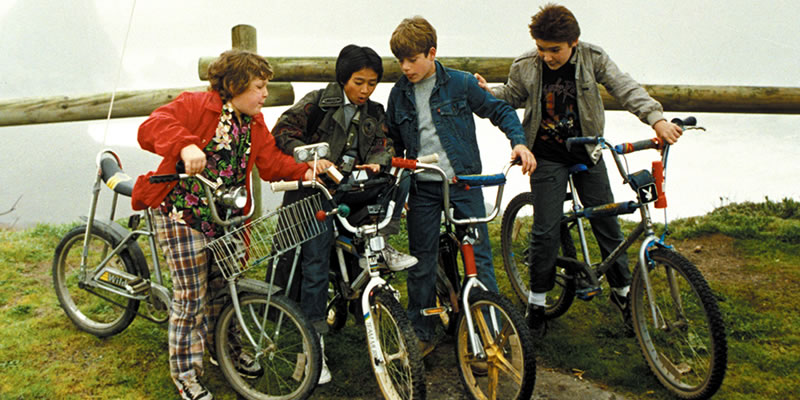
Examples & Inspiration
- IT
- Stranger Things
- E.T.: The Extra Terrestrial
- The Goonies
- Super 8
- Explorers
- Stand By Me
- Attack the Block
- Paper Girls
- Now and Then

